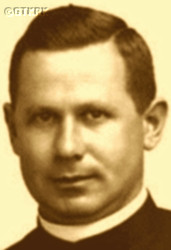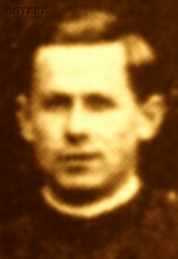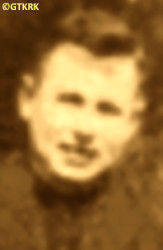Roman Catholic
St Sigismund parish
05-507 Słomczyn
85 Wiślana Str.
Konstancin deanery
Warsaw archdiocese, Poland
full list:
displayClick to display full list

searchClick to search full list by categories
wyświetlKliknij by wyświetlić pełną listę po polsku

szukajKliknij by przeszukać listę wg kategorii po polsku

Martyrology of the clergy — Poland
XX century (1914 – 1989)
personal data
religious status
Servant of God
surname
FRANK
forename(s)
John (pl. Jan)
forename(s)
versions/aliases
Johannes

function
religious cleric
creed
Latin (Roman Catholic) Church RCmore on
en.wikipedia.org
[access: 2014.09.21]
congregation
Society of the Divine Word (i.e. Verbite Fathers) SVDmore on
en.wikipedia.org
[access: 2013.05.19]
(i.e. Verbites, Divine Word Missionaries, Steyler Missionaries)
diocese / province
Warmia diocesemore on
en.wikipedia.org
[access: 2018.09.02]
nationality
German
date and place
of death
03.05.1945

KLW StalinoGuLAG slave labour camp network
today: Donetsk, Donetsk obl., Ukraine
more on
en.wikipedia.org
[access: 2022.08.05]
alt. dates and places
of death
31.12.1945
details of death
After closure on 01.04.1938 by the German National Socialists of the missionary school in Pieniężno (three years later on 03.08.1941 the same ruling German National Socialist inflicted profanation of the Congregation's church and three days later, on 06.08.1941, seized and closed the Mission House — the church was adopted into party meeting hall) left Warmia region and moved to Silesia.
Three years later returned and started ministry in Warmia diocese.
Facing the final Russian winter offensive of 1945 of the World War II — started by German and Russian invasion of Poland in 09.1939 — on German command orders started on 19.01.1945 evacuation, through Pasym towards Biskupiec.
Together with Fr Charles Heinrich reached Stryjewo village.
At the beginning of 02.1945 Russians entered the village.
Barged into the house he was in and threatened to kill all in a hour.
Did not fulfill that promise but on 17.02.1945 (or on c. 28.02.1945) arrested him together with Fr Frank.
Marched them to nearby Jeziorany.
From there transported to Insterburg transit camp.
Next sent — on a railway transport lasting 32 days, in which c. 200 inmates perished — into the–then Russia, to a concentration camp n. Stalino (Donetsk) in southern Ukraine, together with Fr Charles Heinrich and Fr Helmuth Zint, among others.
There slaved in Work Battalion No. 1015 n. Stalino among others.
Soon perished.
cause of death
extermination
perpetrators
Russians
sites and events
KLW StalinoClick to display the description, GulagClick to display the description, InsterburgClick to display the description, Deportation of Germans to Russia in 1945Click to display the description, Ribbentrop‐MolotovClick to display the description, Pius XI's encyclicalsClick to display the description
date and place
of birth
09.11.1900

Niederscheidweilertoday: Rhineland‐Palatinate state, Germany
more on
en.wikipedia.org
[access: 2024.03.19]
religious vows
29.09.1921 (temporary)
1926 (permanent)
presbyter (holy orders)
ordination
26.05.1927

Maria EnzersdorfSt Gabriel missionhouse
today: Mödling dist., Lower Austria state, Austria
more on
en.wikipedia.org
[access: 2021.12.18]
positions held
1942 – 1945
parish priest — Opaleniectoday: Chorzele gm., Przasnysz pov., Masovia voiv., Poland
more on
en.wikipedia.org
[access: 2022.08.05] ⋄ St Joseph RC parish ⋄ Mazurien Ideanery name
today: Warmia‐Masuria voiv., Poland RC deanery
1941 – 1942
administrator — Orzysztoday: Orzysz gm., Pisz pov., Warmia‐Masuria voiv., Poland
more on
en.wikipedia.org
[access: 2022.04.12] ⋄ Sacred Heart of Jesus RC parish ⋄ Mazurien IIdeanery name
today: Warmia‐Masuria voiv., Poland RC deanery
till 1941
teacher — Głubczycetoday: Głubczyce gm., Głubczyce pov., Opole voiv., Poland
more on
en.wikipedia.org
[access: 2021.04.02] ⋄ Minor Theological Seminary (gymnasium) in Maria Treu Missionhouse, Verbites SVD
from c. 1938
teacher — Nysatoday: Nysa gm., Nysa pov., Opole voiv., Poland
more on
en.wikipedia.org
[access: 2021.04.02] ⋄ Minor Theological Seminary (gymnasium) in Holy Cross Mission House, Verbites SVD
1927 – 1938
teacher — Pieniężnotoday: Pieniężno gm., Braniewo pov., Warmia‐Masuria voiv., Poland
more on
en.wikipedia.org
[access: 2022.01.28] ⋄ mathematics, Minor Theological Seminary (gymnasium) in St Adalbert Missionhouse, Verbites SVD — also: minister of Pieniężno parish and the surrounding area
1921 – 1927
student — Maria Enzersdorftoday: Mödling dist., Lower Austria state, Austria
more on
en.wikipedia.org
[access: 2021.12.18] ⋄ philosophy and theology, Higher Theological Seminary in St Gabriel Missionhouse, Verbites SVD
1921 – 1922
novitiate — Maria Enzersdorftoday: Mödling dist., Lower Austria state, Austria
more on
en.wikipedia.org
[access: 2021.12.18] ⋄ St Gabriel Missionhouse, Verbites SVD
1920 – 1921
novitiate — CologneLindenthal district
today: Cologne urban dist., Cologne reg., North Rhine‐Westphalia state, Germany
more on
de.wikipedia.org
[access: 2022.10.06] ⋄ St Augustine Missionhouse, Verbites SVD
03.10.1913 – 1920
pupil — Sankt Wendeltoday: Sankt Wendel dist., Saarland state, Germany
more on
en.wikipedia.org
[access: 2022.10.06] ⋄ Minor Theological Seminary (gymnasium) in St Wendel's Mission House, Verbites SVD
others related
in death
GRAWEClick to display biography Eberhard, HEINRICHClick to display biography Charles, JASCHOLTOWSKIClick to display biography Anthony, PODLECHClick to display biography Ferdinand, ZINTClick to display biography Helmut
sites and events
descriptions
KLW Stalino: Russian Rus. Концентрационные Лагеря для Военнопленных (Eng. POW Concentration Camps) KLW, managed by the genocidal Russian organization NKVD — and in practice by its Rus. Главное управление по делам военнопленных и интернированных (Eng. General Directorate for Prisoners of War and Internees) GUPWI — founded starting from 1942‐1943, in Stalino (now Donetsk), centre of Donbas coal mining and steel making region in Rus. Южный регион (Eng. Southern Region), in Ukraine. Prisoners of these camps — there were 34 of them in the entire region with 515 sub‐camps — slaved in many industrial plants in the region. In 1944‐1946 the Rus. Проверочно‐Фильтрационный Ла́герь (Eng. Testing and Filtration Camp) PFL No. 240 „Petrovskiy” was set up and at the beginning of 1945 had c. sub camps, including in Yenakiyeve, and number of prisoners reached 31,336 (04.1945) and 35,135 (08.1945). POW camp No. 280, known also as „Rutchenkovskiy”, was operational longer. Russians brought there internees from the regions captured by their army who had not managed to escape with withdrawing Germans, among others from Warmia. Most slaved in Donbas coal mines. E.g. on 03.07.1945 Russians held there 49,150 POWs, among whom were c. 4,782 soldiers of Polish Home Army AK and other independent resistance organizations (part of Polish Clandestine State). In 04‐05.1945 Russians sent tens of thousands of miners from Silesia to slave labour in Donbas mines — only some returned to Poland, 10 years later. (more on: pl.wikipedia.orgClick to attempt to display webpage
[access: 2018.09.02])
Gulag: The acronym Gulag comes from the Rus. Главное управление исправительно‐трудовых лагерей и колоний (Eng. Main Board of Correctional Labor Camps). The network of Russian concentration camps for slave labor was formally established by the decision of the highest Russian authorities on 27.06.1929. Control was taken over by the OGPU, the predecessor of the genocidal NKVD (from 1934) and the MGB (from 1946). Individual gulags (camps) were often established in remote, sparsely populated areas, where industrial or transport facilities important for the Russian state were built. They were modeled on the first „great construction of communism”, the White Sea‐Baltic Canal (1931‐1932), and Naftali Frenkel, of Jewish origin, is considered the creator of the system of using forced slave labor within the Gulag. He went down in history as the author of the principle „We have to squeeze everything out of the prisoner in the first three months — then nothing is there for us”. He was to be the creator, according to Alexander Solzhenitsyn, of the so‐called „Boiler system”, i.e. the dependence of food rations on working out a certain percentage of the norm. The term ZEK — prisoner — i.e. Rus. заключенный‐каналоармец (Eng. canal soldier) — was coined in the ITL BelBaltLag managed by him, and was adopted to mean a prisoner in Russian slave labor camps. Up to 12 mln prisoners were held in Gulag camps at one time, i.e. c. 5% of Russia's population. In his book „The Gulag Archipelago”, Solzhenitsyn estimated that c. 60 mln people were killed in the Gulag until 1956. Formally dissolved on 20.01.1960. (more on: en.wikipedia.orgClick to attempt to display webpage
[access: 2024.04.08])
Insterburg: Russian transit camp, set up after capture on 21‐22.01.1945 of Insterburg by the Russians, for German population of East Prussia — on the site of the DL Insterburg camp, i.e. the German prisoner of war camp Germ. Durchgangslager der Luftwaffe (Eng. Air Force Transit Camp), managed by the German Luftwaffe Air Force, where the Germans held, among others, French and British — one of concentration centers of defeated Germans marked for slave work in Russia. In Insterburg (now: Chernyakhovsk) and in nearby Yurbork c. 60,000 people were held: men, women, girls and old. All were transported — in rail transfers lasting 4‐7 weeks, without hot food, proper sanitation — to Russians slave labour camps. Many perished before reaching destination… (more on: bazhum.muzhp.plClick to attempt to display webpage
[access: 2018.09.02])
Deportation of Germans to Russia in 1945: On 06.02.1945 Russian State Defence Committee issued an order to intern all Germans, mainly men, able to work from the German territories captured by Russian army and transport them into Russia — to slave labour camps in Donbas region in Ukraine, to industrial centers in Ural mountains, to Russian occupied Belarus, etc. — in order to rebuild destroyed by the war Russia. It was planned to use c. 500,000 Germans, 17‐50 years old, although in practice much older were also arrested. From Upper Silesia only c. 90,000 Germans and Poles were deported 20% of which returned after many years. Among the victims were members of Polish clandestine Home Army AK (part of Polish Clandestine State) fighting with Germans. Tens of thousands were deported from Warmia and Mazurian regions. (more on: en.wikipedia.orgClick to attempt to display webpage
[access: 2018.11.18])
Ribbentrop‐Molotov: Genocidal Russian‐German alliance pact between Russian leader Joseph Stalin and German leader Adolf Hitler signed on 23.08.1939 in Moscow by respective foreign ministers, Mr. Vyacheslav Molotov for Russia and Joachim von Ribbentrop for Germany. The pact sanctioned and was the direct cause of joint Russian and German invasion of Poland and the outbreak of the World War II in 09.1939. In a political sense, the pact was an attempt to restore the status quo ante before 1914, with one exception, namely the „commercial” exchange of the so‐called „Kingdom of Poland”, which in 1914 was part of the Russian Empire, fore Eastern Galicia (today's western Ukraine), in 1914 belonging to the Austro‐Hungarian Empire. Galicia, including Lviv, was to be taken over by the Russians, the „Kingdom of Poland” — under the name of the General Governorate — Germany. The resultant „war was one of the greatest calamities and dramas of humanity in history, for two atheistic and anti‐Christian ideologies — national and international socialism — rejected God and His fifth Decalogue commandment: Thou shall not kill!” (Abp Stanislav Gądecki, 01.09.2019). The decisions taken — backed up by the betrayal of the formal allies of Poland, France and Germany, which on 12.09.1939, at a joint conference in Abbeville, decided not to provide aid to attacked Poland and not to take military action against Germany (a clear breach of treaty obligations with Poland) — were on 28.09.1939 slightly altered and made more precise when a treaty on „German‐Russian boundaries and friendship” was agreed by the same murderous signatories. One of its findings was establishment of spheres of influence in Central and Eastern Europe and in consequence IV partition of Poland. In one of its secret annexes agreed, that: „the Signatories will not tolerate on its respective territories any Polish propaganda that affects the territory of the other Side. On their respective territories they will suppress all such propaganda and inform each other of the measures taken to accomplish it”. The agreements resulted in a series of meeting between two genocidal organization representing both sides — German Gestapo and Russian NKVD when coordination of efforts to exterminate Polish intelligentsia and Polish leading classes (in Germany called «Intelligenzaktion», in Russia took the form of Katyń massacres) where discussed. Resulted in deaths of hundreds of thousands of Polish intelligentsia, including thousands of priests presented here, and tens of millions of ordinary people,. The results of this Russian‐German pact lasted till 1989 and are still in evidence even today. (more on: en.wikipedia.orgClick to attempt to display webpage
[access: 2015.09.30])
Pius XI's encyclicals: Facing the creation of two totalitarian systems in Europe, which seemed to compete with each other, though there were more similarities than contradictions between them, Pope Pius XI issued in 03.1937 (within 5 days) two encyclicals. In the „Mit brennender Sorge” (Eng. „With Burning Concern”) published on 14.03.1938, condemned the national socialism prevailing in Germany. The Pope wrote: „Whoever, following the old Germanic‐pre‐Christian beliefs, puts various impersonal fate in the place of a personal God, denies the wisdom of God and Providence […], whoever exalts earthly values: race or nation, or state, or state system, representatives of state power or other fundamental values of human society, […] and makes them the highest standard of all values, including religious ones, and idolizes them, this one […] is far from true faith in God and from a worldview corresponding to such faith”. On 19.03.1937, published „Divini Redemptoris” (Eng. „Divine Redeemer”), in which criticized Russian communism, dialectical materialism and the class struggle theory. The Pope wrote: „Communism deprives man of freedom, and therefore the spiritual basis of all life norms. It deprives the human person of all his dignity and any moral support with which he could resist the onslaught of blind passions […] This is the new gospel that Bolshevik and godless communism preaches as a message of salvation and redemption of humanity”… Pius XI demanded that the established human law be subjected to the natural law of God , recommended the implementation of the ideal of a Christian state and society, and called on Catholics to resist. Two years later, National Socialist Germany and Communist Russia came together and started World War II. (more on: www.vatican.vaClick to attempt to display webpage
[access: 2023.05.28], www.vatican.vaClick to attempt to display webpage
[access: 2023.05.28])
sources
personal:
ekai.plClick to attempt to display webpage
[access: 2012.11.23], www.seminarium.org.plClick to attempt to display webpage
[access: 2013.05.19], files.bildarchiv-ostpreussen.deClick to attempt to display webpage
[access: 2018.11.18]
original images:
newsaints.faithweb.comClick to attempt to display webpage
[access: 2013.06.23], www.seminarium.org.plClick to attempt to display webpage
[access: 2013.05.19], www.bildarchiv-ostpreussen.deClick to attempt to display webpage
[access: 2018.11.18]
LETTER to CUSTODIAN/ADMINISTRATOR
If you have an Email client on your communicator/computer — such as Mozilla Thunderbird, Windows Mail or Microsoft Outlook, described at WikipediaPatrz:
en.wikipedia.org, among others — try the link below, please:
LETTER to CUSTODIAN/ADMINISTRATORClick and try to call your own Email client
If however you do not run such a client or the above link is not active please send an email to the Custodian/Administrator using your account — in your customary email/correspondence engine — at the following address:

giving the following as the subject:
MARTYROLOGY: FRANK John
To return to the biography press below:
 Click to return to biography
Click to return to biography










